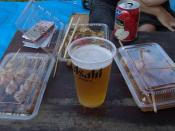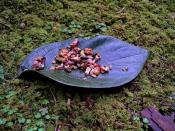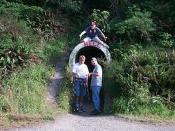The Japanese cultural holiday Obon is short for Urabon and can be traced etymologically to the Sanskrit word Ullambana, literally meaning to "hang upside down". It implies that one must withstand unbearable suffering while being hanged upside down. In the Buddhist script Urabon Sutra, a story is told where a son saves his mother from Hell by making offerings to monks. Through the merits of his actions, his mother was saved from Hell, ascended into divinity, and became a Buddha. Thusly, to save people from Hell (being hanged upside down), one's family and/or friends must make offerings to the deceased.
Obon is held usually in the mid August or July for a week in which the spirits of the deceased are supposed to come back to the land of the living. Being held since the 7th century, it is especially enjoyable to the Japanese people. One of its key features involves offering food items to the deceased.
Vegetables, fruits, rice, candy, rice wine, and among others are offered to the deceased. (But not only the deceased receive food; special foods are made to give away to neighbor, friends, and family.) In addition, respect is shown with floral decorations on the altar or gravesite along with incense burning and prayer. Particularly, prayer is said for wayward spirits that have passed away in the recent year, as it's said they need more guidance to find their way. The Festival of the Dead, as it's sometimes called, is a celebratory and social event. While this is not a national or public holiday, plenty of people from the city go back to their hometowns to polish up and clean their ancestor's gravesites.
On the actual day of the celebration, a menagerie of lanterns, in a multitude of colors, are hung all around the town and specifically on houses. The logic is this - since spirits come back, the lanterns will guide them to and from the spirit world. However a more realistic use for these is lighting the area where the bon dances will take place. The bon dances have religious undertones also. In the story above, the dancing signifies the joy and elation the son felt when his mother was offered divinity. Now, in the center of town, a makeshift tower is erected. A Taiko drummer is on top and speakers play special Obon music and dancers below dressed in yukata (summer) kimonos circle below in dance. The dance is basically very simple with motions depicting digging, plowing, and so on. These dances and music differ from district to district.
Around is the festival. Games and food stalls are abundant, much like the recent Chinese New Year celebrations. After a week has passed, the peak of the celebration is eminent - the Toro - Nagashi. This is when little boats bearing candles and sometimes names of the deceased are floated down rivers or into the ocean. This is for religious purposes, guiding the spirits back to their world. However for environmental purpose, this has been discontinued in many areas. Kyoto is an exception, where people eagerly watch these floats.
At the end of the week, preparations are undone, all aspects of celebration over, everyone returns to their homes - the city. Public transport is very often hell and filled to the brim with their double capacity. The spirits return to their world and the jovial Japanese return to theirs.



